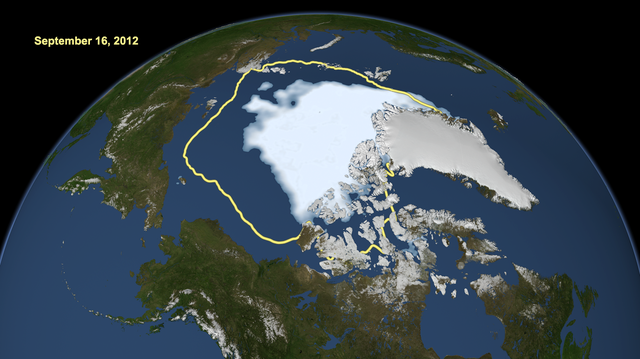
The extreme melt of Arctic sea ice has stopped for the year, but only after setting a record low for area covered, . Arctic sea ice covered about 1.32 million square miles on September 16, when scientists said the extent was likely* at its lowest point for the year. That area is difficult to imagine. Picture this: In the lowest previous minimum year for ice extent, 2007, there was an area of ocean the size of Texas covered with additional hard white stuff. Now picture this: The state of Alaska times two. That's the area this year's minimum sea ice extent was smaller than the annual average since measurements were first taken in 1979.
“Climate models have predicted a retreat of the Arctic sea ice; but the
actual retreat has proven to be much more rapid than the predictions,”
said Claire Parkinson, a climate scientist at in Greenbelt, Maryland. “There continues to be considerable interannual
variability in the sea ice cover, but the long-term retreat is quite
apparent.”
In other words, this record low happened sooner and faster than scientists thought it would, and it's definitely part of a trend.
https://www.youtube.com/embed/9Gsr1503TNg
Watch how the winds of a large Arctic cyclone broke up the thinning sea ice cover of the Arctic Ocean in early August 2012.
Overall temperatures this summer were cooler in the Arctic than they were in 2007, but two main things likely contributed to the record low measurement this September. Sea ice may have been thinner this year after successive years with less ice cover. The six lowest measurements for minimum sea ice extent have occurred in the last six years. A cyclone that formed off the coast of Alaska and hovered over the Arctic in early August likely broke up the ice and led to further melting. (The same storm trying to row across an increasingly ice-free Arctic at bay.) But blaming one bad weather incident for the loss of ice would miss a larger point.
“The storm definitely seems to have played a role in this year's
unusually large retreat of the ice,” Parkinson said. “But that exact
same storm, had it occurred decades ago when the ice was thicker and
more extensive, likely wouldn't have had as prominent an impact, because
the ice wasn't as vulnerable then as it is now.”
*Changing winds could push ice floes together and lead to a reduced measurement.
—Joe Spring